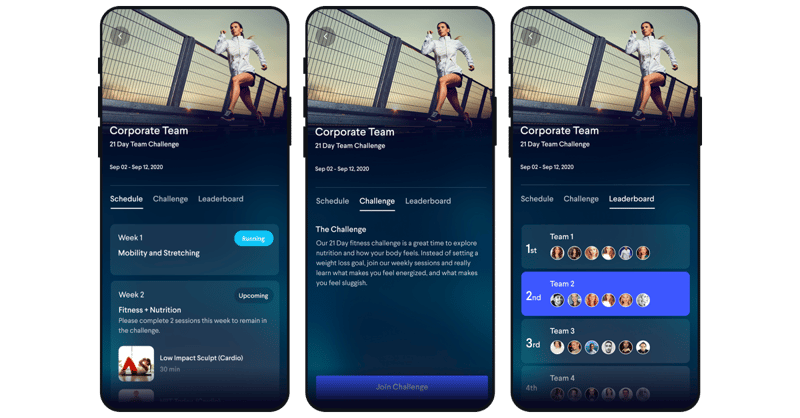Though company involvement in employee well-being often ends at “how was your weekend?,” it raises another question: why do most managers stop there?
With the average American spending the majority of their waking hours working and one out of every four people naming work as their biggest life stressor, maybe it’s time for companies to lend a helping hand to their teams.
During challenge times, spouses, friends, and family members are a person’s biggest sources of support. Unfortunately, these aren’t the people your employees spend most of their time interacting with during the day—it’s their managers, their team members, and their work.
Prioritize Mental, Physical, And Social Well-Being
First and foremost, employees are people with changing mental states, immune systems, physical bodies, and feelings. Add in the challenges of remote work and a stressful year in general, it’s no wonder why your remote employees may be in need of extra, total wellness support.
Leadership teams have responsibilities that extend far beyond hitting quarterly goals and leading a team—they include supporting employees not just in their professional growth, but in their overall well-being. Yet, 44% of U.S. companies don’t have any wellness initiatives for their employees.
.png?width=800&name=Blog_Images_(1).png)
With proper knowledge and intention, it is possible to crack the code of remote employee wellness and start making it a priority for your team. Follow the best practices below to get started on improving the physical, mental, and social health of your team.
Build A Culture Of Connection
Before it’s possible to make a real difference in the wellbeing of your employees, there may need to be a culture shift first. If your organization isn’t already people-focused, it’s time to make strides in that direction.
A people-focused company is one that prioritizes their employees over a sale, transparency over secrecy, and support over expectations. Being people-focused means recognizing the value of each employee and focusing on making connections and improvements on a human-level instead of keeping them at a distance.
.png?width=800&name=Blog_Images_(2).png)
When building a culture of connection and trust from the ground up, start small. Simple things like an appreciative, heartfelt monthly message from the CEO, active listening during 1:1 meetings, and displaying vulnerability when it’s easier to put up walls in times of change are ways you can make a culture shift for the better. Once you’ve built a connected and trusting culture, you can begin to pave the way for more specific well-being improvements.
Support Healthy Physical Habits
Physical factors like sleep, exercise, diet, and water intake have more of an effect on your employee’s daily performance than you might think:
- Regular and quality sleep can boost decision-making and creative abilities.
- Regular exercise improves concentration, motivation, memory, and mood.
- Proper hydration increases energy and reduces fatigue.
- A low-sugar diet reduces inflammation and improves brain function.
While you can’t exactly show up on your employees’ doorsteps to make sure they’re staying healthy, there are ways to lead your remote employees towards better physical habits from afar.
1. Help Employees Create Time and Space For Physical Wellness
If you notice one of your employees regularly working late into the night, working over the weekend, or not taking lunch breaks, encourage them to set boundaries with their time.
To do this, help them schedule breaks throughout their day and train them on the importance of enjoying their time outside of work, and making that time a priority. Without the time specified in their day for a walk, workout class, or time to make a healthy lunch, chances are they’ll continue chugging through their tasks without a second thought.
If your employee expresses that they feel burnt out and don’t have time for physical activity, it may be time to redelegate or reprioritize tasks and projects.
2. Model Healthy Behavior
Employee see, employee do—and they’re looking at you, managers! Make your own healthy wellness practices visible to your remote team by letting them know via chat or email that you’ll be offline temporarily to partake in some sort of physical activity.
By modeling wellness as a behavior to your team, they will start to realize that they too can make wellness a priority within their workday. Share a healthy recipe, a link to a yoga class you enjoyed, a pre-meeting meditation that you practice, or a photo from your lunchtime walk scenery to start inspiring your team to do the same.
3. Encourage Accountability With A Team Wellness Challenge
Hands down, the best way to make an impact on your team’s physical wellness is by hosting a wellness challenge. A little competitive spirit can go a long way, after all!
Popular wellness challenges include:
- Reach the most walking miles in X weeks
- Cook at least 4 healthy meals a week for X weeks
- Attend the most yoga sessions in 1 month
⭐️ Within the Wellness Coach platform, managers can organize remote team wellness challenges based on their interests and goals. You can keep track of who’s in the lead and partake in virtual wellness classes together as a team.

Prioritize Mental Health
Just as you should help facilitate better physical wellness practices for your team, you should do the same with supporting their mental wellbeing.
A recent study led by WHO found that more than 300 million people around the world suffer from depression and another 260 million from anxiety, with many living with both conditions, and such disorders cost the global economy $1 trillion in lost productivity each year. So if you were thinking to yourself, ‘employee mental health isn’t my business’—in a way, it is.
1. Talk Openly About Mental Health
An effective first step in getting your employees more comfortable with the idea of discussing aspects of their mental health in the workplace is by talking openly and regularly. Just the simple idea of making mental health topics more familiar can allow employees to feel comfortable coming to management when they need support. This can go a long way toward helping employees get what they need to improve their mental health daily.
2. Be Vulnerable And Actively Listen
Instead of asking ‘how are you?’ to your employees, ask more meaningful questions, like “How is your mind feeling today?” or “describe how your month has felt in three words”. Just a simple “How are you?” may not be enough to allow your employees to feel invited to share how they feel with you.
A great way to encourage honest communication is by offering vulnerability first. Do this with your team by opening up a conversation with a vulnerable statement followed by a solution. For example, during a 1:1 meeting you could say: “I’m feeling overwhelmed today, so I’ve scheduled 5-minute meditations into my schedule. How are you feeling today?”.
This will help your team to feel more connected to you and will hopefully spark a conversation about their own mental state and ways to improve it.
3. Encourage Mindfulness Practices
Meditation and mindfulness have shown to not only help enhance work satisfaction, but also enhance productivity and general happiness. Meditation has also been proven to reduce stress, calm the mind, and improve self-awareness.
Facilitate improving the mental health of your team by incorporating virtual meditation or yoga sessions into your weekly team schedules.
⭐️ Wellness Coach can be used on desktop and mobile, and can easily be integrated with Slack so teams can use the program throughout their workday, regardless of where they’re located. The app is perfect for on-the-go meditation, yoga, or mindfulness.

Promote Social Wellness By Reducing Remote Isolation
With feelings of isolation being one of the biggest struggles remote workers face, it’s important to help facilitate social interaction within your team. Without intentionality, moments of team bonding will fall by the wayside and your team may start to feel disconnected and lonely.
1. Schedule Regular Team Bonding
Schedule regular virtual meetings that are dedicated fully to team bonding. While this may seem cheesy or even like a waste of time, regular team bonding has been shown to build trust, regulate communication, increase productivity, and make collaboration easier.
Fun ideas for team building activities include:
- Two Truths And A Lie: The rules of this virtual game are simple: Write down three statements, two of which are true and one of which is false. Read all three statements out loud and give your team a minute to guess which of the statements is false. You’d be surprised how many times you can play this before you run out of fake things to share, or eventually knowing your co-workers so well, that you can easily tell when they are lying.
- Virtual Happy Hour: This one’s easy! Grab your drink of choice and gather virtually with your team to discuss anything non-work-related.
- Virtual Show And Tell: In advance of your next meeting, instruct your team members to pick an object in their house that has a fun story behind it and bring it to the next meeting. This is a great way for team members to get to know each other on a more personal level and make connections.
If your team is feeling like they could use a bit of movement in their workday, treat your team to a private group class to practice yoga, fitness, meditation, or leadership. A virtual session with one of Wellness Coach’s skilled coaches is a great way to bring your team together.
Be Well, Together
With a happier and healthier team comes a more productive and collaborative team. Show your employees just how much you care about their wellbeing by implementing these practices into your weekly and monthly routines.
⭐️ Wellness Coach offers customized wellness programs for organizations, as well as live stream individual and group classes to create more resilient, healthy, and productive teams.
Want to learn more about maintaining a wellness culture in a distributed workforce? Watch the recording of our recent webinar where industry experts offer their advice on best practices.
.png)

.svg) Share
Share.svg) Tweet
Tweet.svg) Post
Post.svg) Mail
Mail